Plant vs. PredatorOnce every 48 years, all hell breaks loose for the farmers living in the State of Mizoram in northeast India. As for farmers in other parts of the region and in different years, a plague of black rats appearing seemingly out of nowhere sweeps through their fields, gorging on their crops. The cause? A species of bamboo called Melocanna baccifera. After millions of years of predation on its seeds, this species evolved a neat defensive trick: flower and fruit only every half-century and at exactly the same time as your neighboring Melocanna bamboo, and produce one mother of a seed (for a bamboo). In this interview, noted ecologist Daniel Janzen of the University of Pennsylvania describes how this plant's strategy came about and what's in it—both good and bad—for the bamboo, the rats and other predators, and anyone living nearby. All in the timingNOVA: Why do bamboo species like Melocanna baccifera flower and seed all together at the same time? Dan Janzen: I think for two reasons. One is the physiological/ecological reason, which is that they're all on the same calendar. They're all counting the same way, and they all come out on the same year. The other is that there's been strong selection throughout the history of that plant for them to all seed and flower at the same time, because that means there's a huge number of these highly edible seeds hitting the ground all at one time, which satiates all the seed predators that are at that spot. Then they are not seeding for a very long time, and the animals who eat those seeds, their density goes way down. So the next time this happens, again, they are at a very low background density, and, again, they're satiated by this very large seed crop, which appears magically from their viewpoint after 48 years. Q: So the timing, the sychronicity, is critical to achieving this satiation? Janzen: Well, it's very easy to imagine that anybody who seeded early or late would really get hit by the animals. Because in the beginning, if you have a normal background set of predators and just one small set of seeds yourself, then all your seeds get eaten. And if you come along and seed a year later [after a major synchronized seeding], you're dropping yourself into a huge pool of predators. So there's strong selection for you to be right on time. And to have as big of a seed crop as you can, because if you have a little seed crop, well, maybe all your seeds will be gobbled up. Q: And because the plants put out so many seeds, enough survive to pass on their genes. Janzen: Yes. I think it's fair to say that in predator satiation, the plant—or animal—makes so many kids that the predators are all filled up, with the outcome being that the remaining large number of kids survive. In the evolutionary sense, the plant or animal puts its energy into making a very large number of kids at one time, instead of making fewer kids spread over time. Thus, classically, in predator-satiation cases, each of the kids just sits there. It has no escape behavior. It's very easy for predators to eat it, so the predators fill up right away. From the parent plant or animal's standpoint, the selection is to make a large number of kids, rather than to make each kid very well defended, very tough, very smart, very behaviorally resistant, or to hide them or anything like that. Animals do it, tooQ: What's a good example of this among animals? Janzen: Probably the most well known is salmon. Before we started killing very large numbers of them, salmon had evolved the behavior in which a juvenile salmon goes out to sea, lives for three or four years, growing up and getting very big and not reproducing during that time. No mating, no egg production, just getting big. Then it and all the others from the same population go up their natal river sometime in the spring and all lay huge numbers of eggs in that stream and die. They burn themselves out in one reproductive event. Now, that stream is wall-to-wall eggs and little fingerling salmon, so everybody who eats young fish and fish eggs, all the insects and birds, the fish, everybody, just stuffs themselves with baby salmon. There's vastly more than they can possibly eat. And any salmon that survives all this predation then goes out to sea and lives like a normal fish for three or four or five years and then repeats this process. The next year, another cohort of salmon who are out of phase by one year with the previous ones does the same thing. "Passenger pigeons came by the millions and ate literally billions of acorns." Q: With grizzlies being one of the chief predators they're satiating? Janzen: We've all seen pictures of grizzly bears catching salmon on a salmon run. Well, the bears were heavily dependent on that big spring run of salmon. They specialized on eating an enormous amount of salmon, getting very fat. That was their big pulse of food, which lasted basically much of the rest of the year for them. And the whole bear biology was set up around that big pulse. Bears can live other ways, too, of course, but they responded to that big pulse by gobbling up large numbers of adult salmon. But there were so many salmon in the river that those adults were satiating the bears. The oak and the passenger pigeonQ: Are oak trees and their periodic "masting" of acorns another example of this among plants? Janzen: Yes. In the old days, had you lived in North America when we had huge expanses of oak and beech forest—well, take the oak tree, for example. Perhaps all of eastern Pennsylvania may have seeded acorns in one year. Three years later, all those trees would have produced acorns again. In between, during those three years, they'd produce almost no seeds. So the squirrel density would go way down, the deer density would go down. Everybody had a really tough time in between those massive acorn crops. But, of course, the year the massive crop was produced, the turkey and the deer and the squirrels all did extremely well. (See Population Explosion for an interactive look at this cycle.) And, incidentally, the passenger pigeons came. They came by the millions and ate literally billions of acorns. Every passenger pigeon put six acorns in its crop, and you've got a flock of, say, five million passenger pigeons. Five million passenger pigeons times six acorns every day—you can see how many acorns they could eat. But they had to have that kind of food input to stay in the game, so when the acorns were exhausted or had germinated or winter came, the pigeons had to fly to some other place where another one of these mass seed crops was being produced. The passenger pigeon had this reputation of being a migratory bird that flew all over the place. Well, it was flying from acorn crop to acorn crop, and it did the same thing with beech trees. [Editor's note: The passenger pigeon became extinct in 1914, when the last known survivor, a female named Martha, died at the Cincinnati Zoo.] Q: Are these trees, the oak and the beech, synchronized with one another like the Melocanna bamboo? Janzen: Well, imagine what would happen if all the oaks were not synchronized and just produced a moderate number of acorns each year. You'd have a whole lot of fat and happy passenger pigeons who would fill up on acorns every year, and there wouldn't be any surviving acorns. So what you do is get selection for the trees to respond to cues. In the case of the acorns, I think it was two things—a dry spring, and enough reserves stored up. So you stored for a while, and then a dry spring came along, and that was the cue [for all the oaks to produce a huge seed crop]. That's different from the bamboo. The bamboo is counting years, while oak trees were using a weather cue. And the oak trees didn't die after seeding. "You can jam a lot of rats into one place if you have a lot of food." Q: Why does the Melocanna bamboo die after seeding? Janzen: This has puzzled people for a long time. And it has concerned them, too, because people have long depended on bamboo, so when it all dies, you have a problem. There are probably two "whys." Again, there's the evolutionary why: I put all my reserves—and I mean all of them—into making this monster seed crop, so I basically burn myself out. The other why is that bamboo is not just a single-stem plant. One bamboo plant, with thousands of stems, might cover one or two square miles, so each individual plant owns a big piece of terrain. If I'm going to produce a very large number of kids, many of which are going to get eaten, but I want the kids who don't get eaten to have an open spot of sunny ground on which to grow, one way to do it is to literally kill myself. In an oak forest, when they mass-seed, each oak tree does not die, as we've said, so those acorns, most of them, will be in the shade of the parent. They're going to have a terrible time making it to adulthood. Feast or famineQ: What predators besides rats feed on these big bamboo seed crops? Janzen: The animals who eat bamboo seeds can be divided into two groups. One is the animals who simply find suddenly that there are bamboo seeds everywhere so they eat some, and then that's just more food. There are many animals who do that, because the seeds are highly edible. Then there's a set of animals who specialize on these big seed crops, like the passenger pigeon did. In Southeast Asia, it's chickens, pigs, and rats. All of these animals seem to be evolutionarily specialized on this big seed crop, and when it happens, they reproduce like crazy. Q: What about all those years it doesn't happen? How do these specialized predators cope? Janzen: Zoologists have been curious about this for quite a while. In between the big crops, seed predators have two ways of staying in the game. One is that they're very good at living on almost nothing. They turn off their reproduction, and they literally don't have kids for years. And the smart, old adults make it by eating sort of everything. They're generalists; they can eat anything, anywhere, and just barely maintain their body weight. The other way of doing it is to migrate like the passenger pigeon—move from seed crop to seed crop to seed crop. Wild chickens are one of the major bamboo seed predators. They were specialized. They were very good at moving long distances. But they were also very good at starving in between. Wild pigs are also famous for having moved long distances between mast seed crops. Q: What about rats? Do they migrate? Janzen: Rats aren't good at moving long distances, so when the seed crop runs out they basically starve and go down to very low densities and live on everything, just like rats do in your dumpster. And they reproduce very rarely during that time. They have small litters, and the litters don't survive very well. Until there is a big bamboo seed crop, of course, and at that point mama rat makes six or eight kids, and they all grow up very fast and make more kids. So they do very well on this big seed crop for several generations, just like they do in a farmer's granary. He's got a big silo full of grain, which is like one big seed crop, and the rats get in there, and then they begin reproducing like crazy. Behavior modificationQ: Besides gorging and reproducing, does their behavior change? Do they act differently? Janzen: Well, the very interesting thing about that is when they have this huge amount of food available to them, they don't fight with each other very much. So you can jam a lot of rats into one place if you have a lot of food. The same applies to chickens. You can put a whole lot of chickens in a barnyard if the farmer is putting lots and lots of grain out there, which is a big bamboo seed crop really. Then the roosters don't fight very much, the hens all get along well with each other, and they make lots of eggs. Pigs are the same way. Starving pigs are quite territorial, and they fight a lot and are not pleasant animals to have around. Whereas if you feed a pig a great deal of food, she becomes quite a happy barnyard animal, and she makes large numbers of kids. She's spectacular in that she's the only big mammal that makes large litters—10, 12 individuals. That was not selected for by farmers; that's the way they are in the wild. Now, mama pig can't support those 10 pigs on just her milk. Those kids start eating real food very soon, and in nature they would start eating bamboo seeds almost immediately. So her milk is enough to supplement the bamboo seeds, and then you grow up a litter of baby pigs. Well, of course, the farmer does this by feeding grain and thereby artificially giving all of this food to the pig. Chickens are the same way. When you starve a chicken, it can still make it by eating grass and a few insects here and there, and it makes either no eggs for a long time or just a very few eggs. Then you give it a lot of grain in your barnyard and boom, suddenly it starts churning out eggs. That is exactly the same as a wild chicken does when it encounters a bamboo seed crop. "I just couldn't believe this was a wild chicken, because it looked exactly like a rooster out of an Iowa farmyard." Q: What about the huge seeds of the Melocanna? Wild chickens couldn't handle them, right? Janzen: Melocanna bamboo does have exceptionally large seeds. They were described by Indian surveyors in the 1800s as being the size of a pear. I've personally never seen one, so I'm not sure whether they're as big as a pear, but they're big, whereas most bamboo seeds are more the size of a kernel of corn down to the size of a rice grain. Obviously, a chicken is not capable of swallowing a seed the size of a plum or pear. So chickens were probably not a major selective pressure for Melocanna bamboo. But many, many species of bamboo have smaller seeds, and chickens were major seed predators on them. Wild rats, wild pigs, and all the other mammals in the undisturbed community—elephants, rhinos, porcupines, etc.—would have no problem with the big seeds, but the seeds' size would at least give them protection against the wild chickens. Meet the bamboo fowlQ: Somehow it's hard to think of your average barnyard chicken as once being a wild animal! Janzen: Well, chickens are a very interesting part of the bamboo story. I first became clued into this while I was sitting in a little restaurant in Malaysia on the edge of a national park. I was finishing my lunch and thinking about what I was seeing around me in this big, gorgeous rain forest, and suddenly a big, beautiful rooster walked out of the forest and up to this little restaurant and started picking up scraps of sandwiches off the ground. I said to the restaurant owner, "Whose chicken is that?" He looked at me and said, "It's nobody's." I said, "Wait a minute, where's the farmyard that this chicken came from? Is that your chicken?" I thought he was afraid to admit that this was his chicken, because he was in a national park. But he said, "No, that's not my chicken. That's a wild chicken." I looked at this rooster, and I just couldn't believe this was a wild chicken, because it looked exactly like a rooster out of an Iowa farmyard. I then started looking into the biology of these things, and the first thing I discovered was that the local name all throughout Southeast Asia, in whatever language, is bamboo fowl. So this word chicken that we put on it hides what its real name is. And if you look at chickens as a whole, they're just a pheasant. There are many, many species of pheasant in the Old World, and one of them specialized on bamboo seed. That gave it a very different biology than all the other pheasant species have. Q: They thrived on bamboo seed crops. Janzen: Right. This rooster I met in the Malaysian rain forest, it turns out he had a harem of hens out there, just like hens out of some barnyard, running around in the rain forest, eating very little, doing very little. And what I learned by reading old literature was that they sat there doing almost nothing, eating insects, eating bits of leaves, reproducing very little, until a bamboo seed crop occurred in their area. Then that rooster and his harem, and all the other bamboo fowl, would go to that bamboo seed crop. And when they got there, they would stop being territorial, stop fighting with each other, all the hens would eat like crazy, and all would make these big litters of six, 10, 12, 14 eggs. The chicks would hatch very quickly, and the amazing thing about them is they could live on nothing but bamboo seeds as grain. Now, all farmers know that you can feed chicks grain. Not a problem. But all the other pheasant species, when they're chicks, they have to have insects. They also grow slowly. They live as somewhat territorial animals. They do eat bamboo seeds, but they don't perform this great reproductive event that chickens do. Big eaters for a big seedQ: So elephants and rhinos also used to take advantage of the burst of Melocanna seed? Janzen: Yes, elephants, rhinoceri, and other large animals like porcupines that can eat large quantities of stuff. Of course, elephants and rhinoceri are no longer running wild around the Indian countryside. But 500 years ago, and during all the evolution of Melocanna bamboo, literally hundreds of rhinoceri and elephants would have been within walking distance of that fruiting Melocanna bamboo patch. Every single one of them would have gone to that patch and consumed hundreds of kilos of these big fruits every single day. "And where did the plague of rats come from? They didn't fall out of the sky like rain." Q: But elephants and rhinos didn't start cranking out kids after a massive seeding, did they? Janzen: No. The rhino and the elephant would not have suddenly started churning out baby rhinos and baby elephants. They are simply capable of eating a very large quantity themselves, so they were important seed predators, but not in a reproductive-response kind of way. Whereas the rats, pigs, and chickens, they would churn out kids. Incidentally, a newborn pig can be reproductive in six months if it's got a lot of food. So if that bamboo seed crop lasts a year and a half, you're looking at two or three generations on site. And a baby rat can be reproductive in six weeks, so with them you're talking about a very high reproductive response. The human tollQ: Which causes a plague of rats that, after the seeds are gone, devastate farmers' fields. Janzen: Yes. If there are rice or corn fields nearby, they move directly into those, because it's just another grain; it's just like another bamboo seed crop. And, of course, the people who live there get very upset about having all their grain eaten, whether it's stored grain or rice in the fields. You have people talking about how "the rats suddenly, magically, appeared and caused a plague of rats, which then ate all of our food and then we had a famine." Well, this has been going on in Indian and Southeast Asian history for many, many centuries. As long as there are written records, there are reports of how there was a plague of rats and then there was a famine. And where did the plague of rats come from? They didn't fall out of the sky like rain. They came from a bamboo seed crop. |
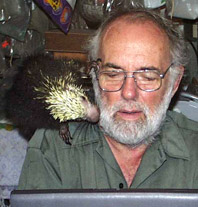
"When it happens, they reproduce like crazy," Dan Janzen says of the rats, pigs, and wild chickens that evolved to take advantage of the mass fruiting of Melocanna baccifera and similar species of bamboo. Above, Janzen with "Espinita," a prehensile-tailed porcupine that shared his life until she, as he put it, "took the boat to Valhalla." 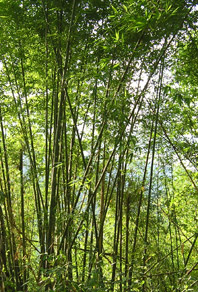
Different stands of Melocanna bamboo, like this one in India's Mizoram State, all flower and fruit at the same time—for good reason, Janzen says. 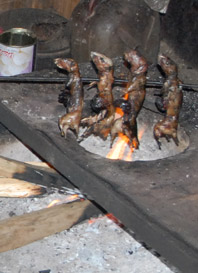
When marauding rats devour their grain, Mizo farmers turn the tables on the rodents, killing and eating them. Here, a Mizo villager prepares what he considers a gourmet meal. 
Click on the image above to see an interactive on the best-studied periodic mass fruiting, that of North America's oaks, and its impact on wildlife. 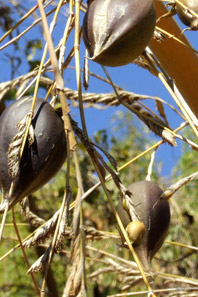
After Melocanna bamboo flowers and fruits, it dies, clearing the way for seeds fortunate enough to survive predation to germinate and flourish. 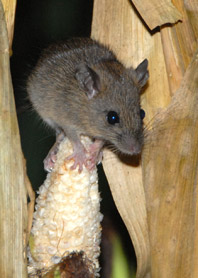
Most Westerners think of the black rat as a generalist, eating most everything. But in its native home of India and Southeast Asia, Rattus rattus evolved to specialize on bamboo seed crops. Above, a black rat feeding on corn near Zamuang. 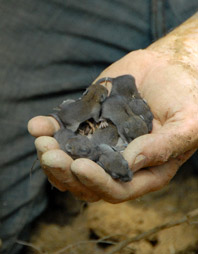
A two-week-old litter of baby rats during the mautam, the local name for the mass fruiting of Melocanna bamboo that takes place only every 48 years. 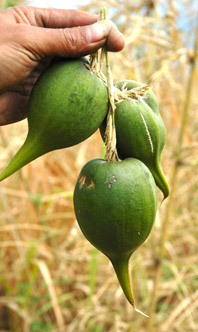
For bamboo, the seeds of the Melocanna are gigantic, part of the plant's evolved defensive strategy against predators that savor the fruit. 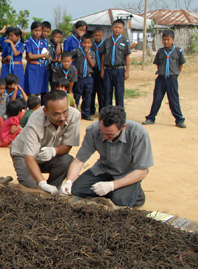
To help control rodent outbreaks, the Mizoram government pays farmers two rupees (about two cents) for every rat they kill. Above, with a crowd of young Mizo looking on, Ken Aplin (kneeling at right) and James Lalsiamliana of Mizoram's Agriculture Department examine a pile of 30,000 rat tails. |
|
Interview conducted on September 30, 2008 by Rick King, producer of "Rat Attack," and edited by Peter Tyson, editor in chief of NOVA Online Rat Attack Home | Send Feedback | Image Credits | Support NOVA |
© | Created February 2009 |
|
|
|

